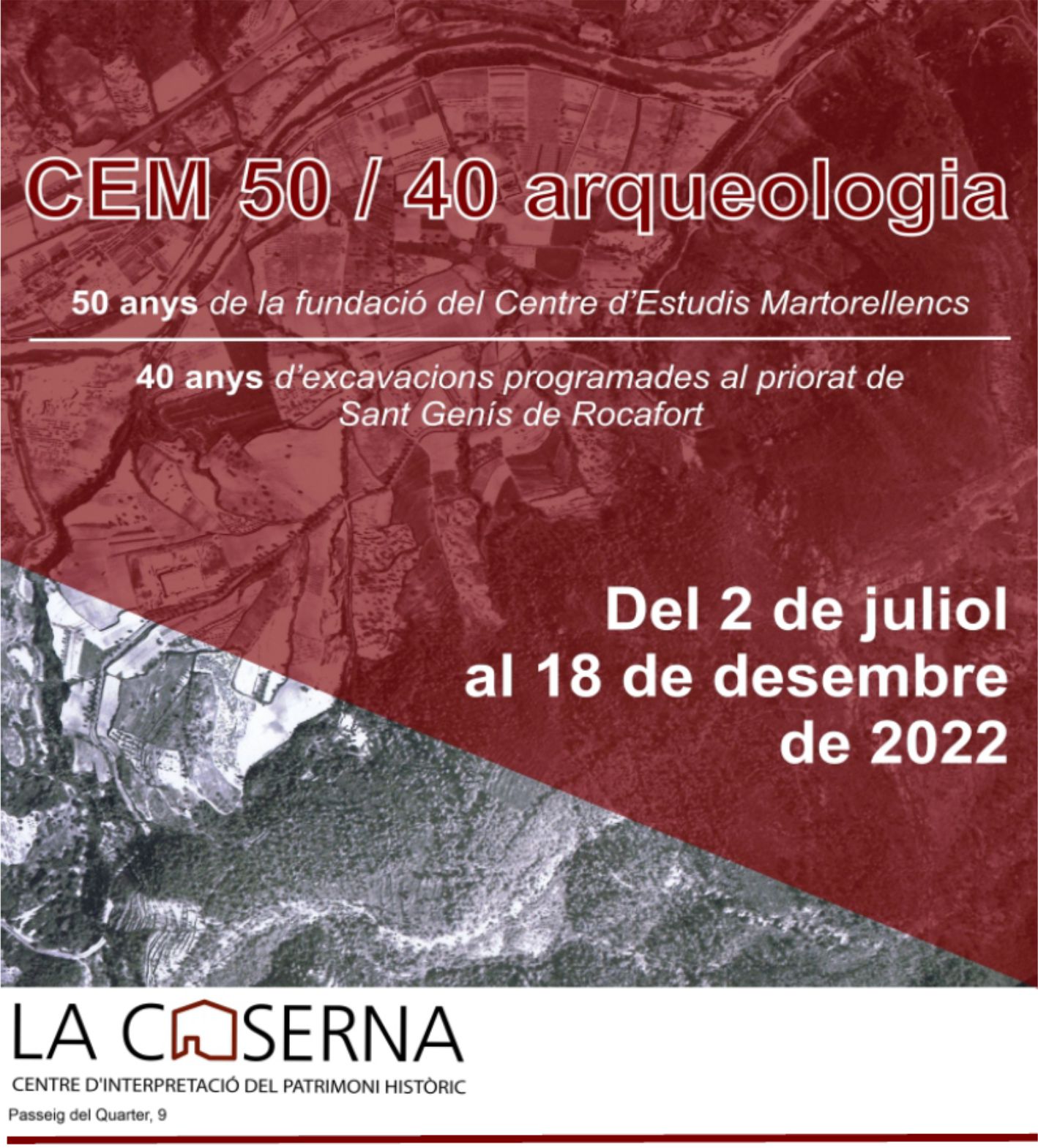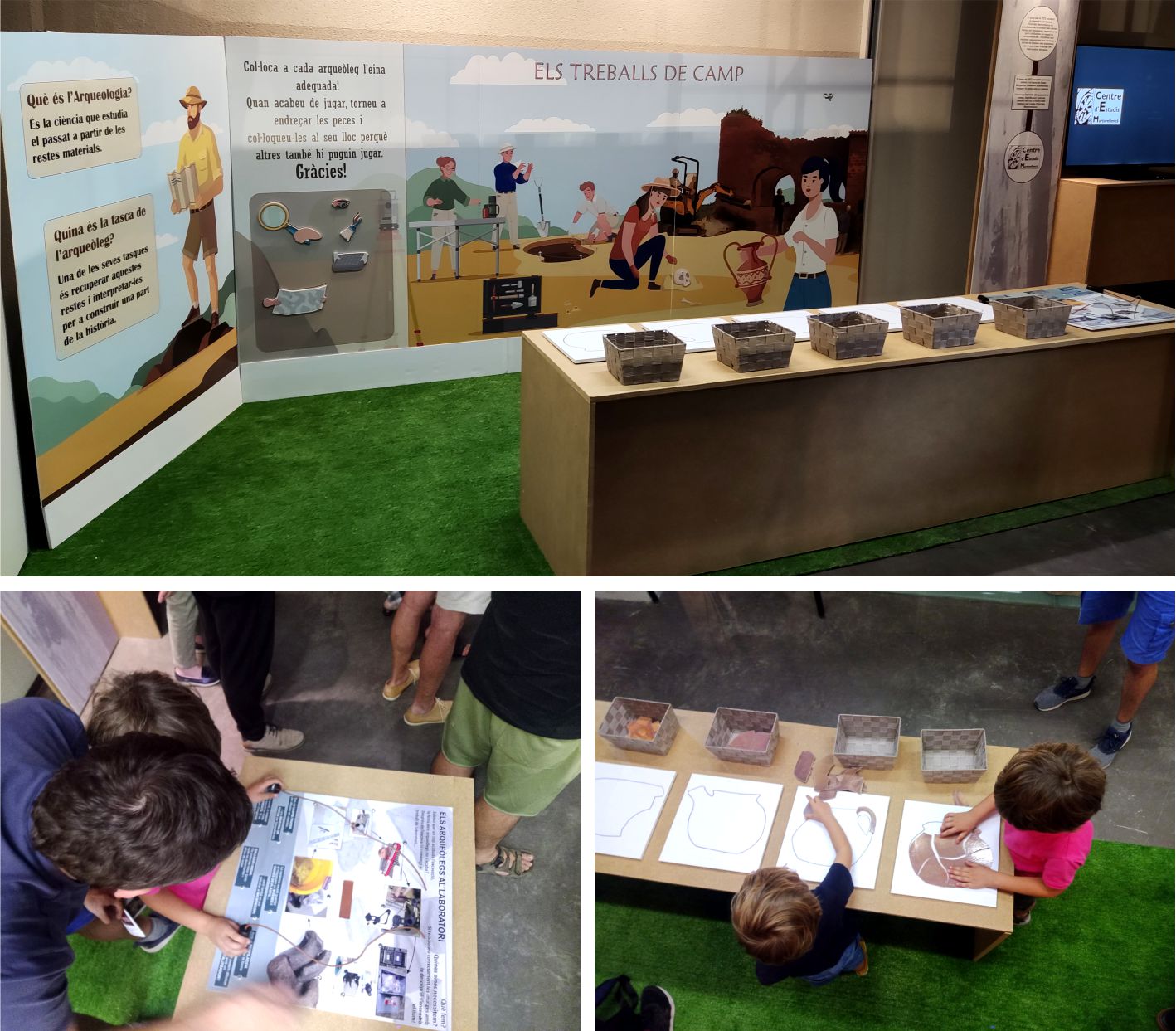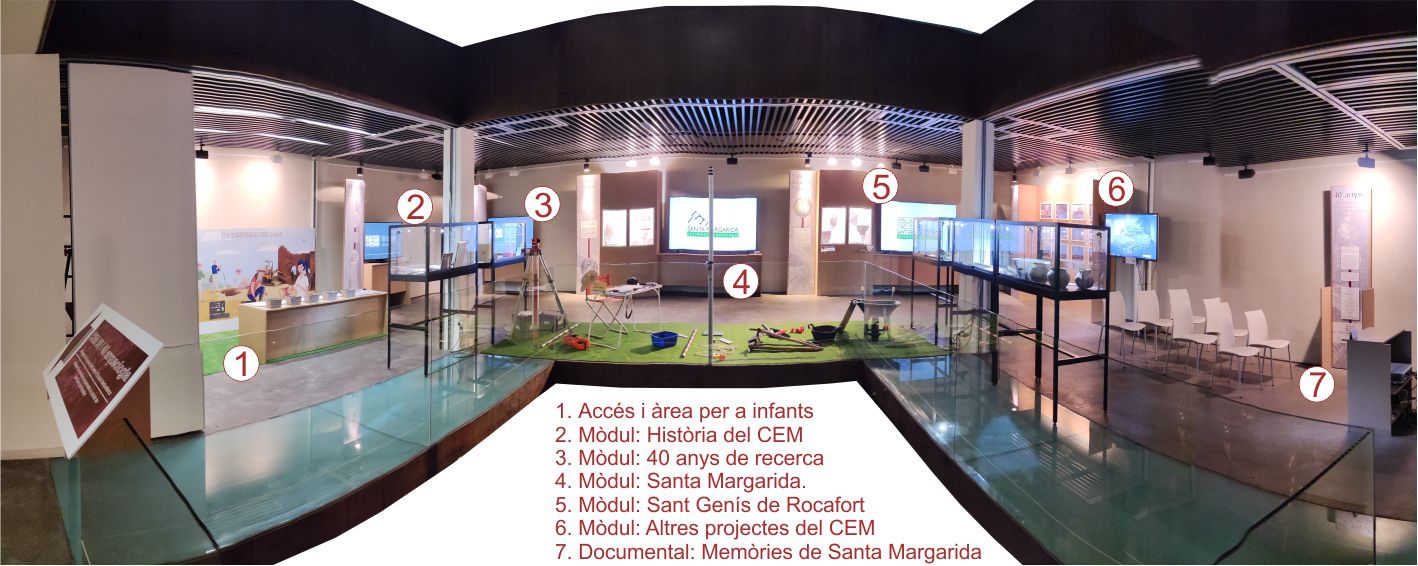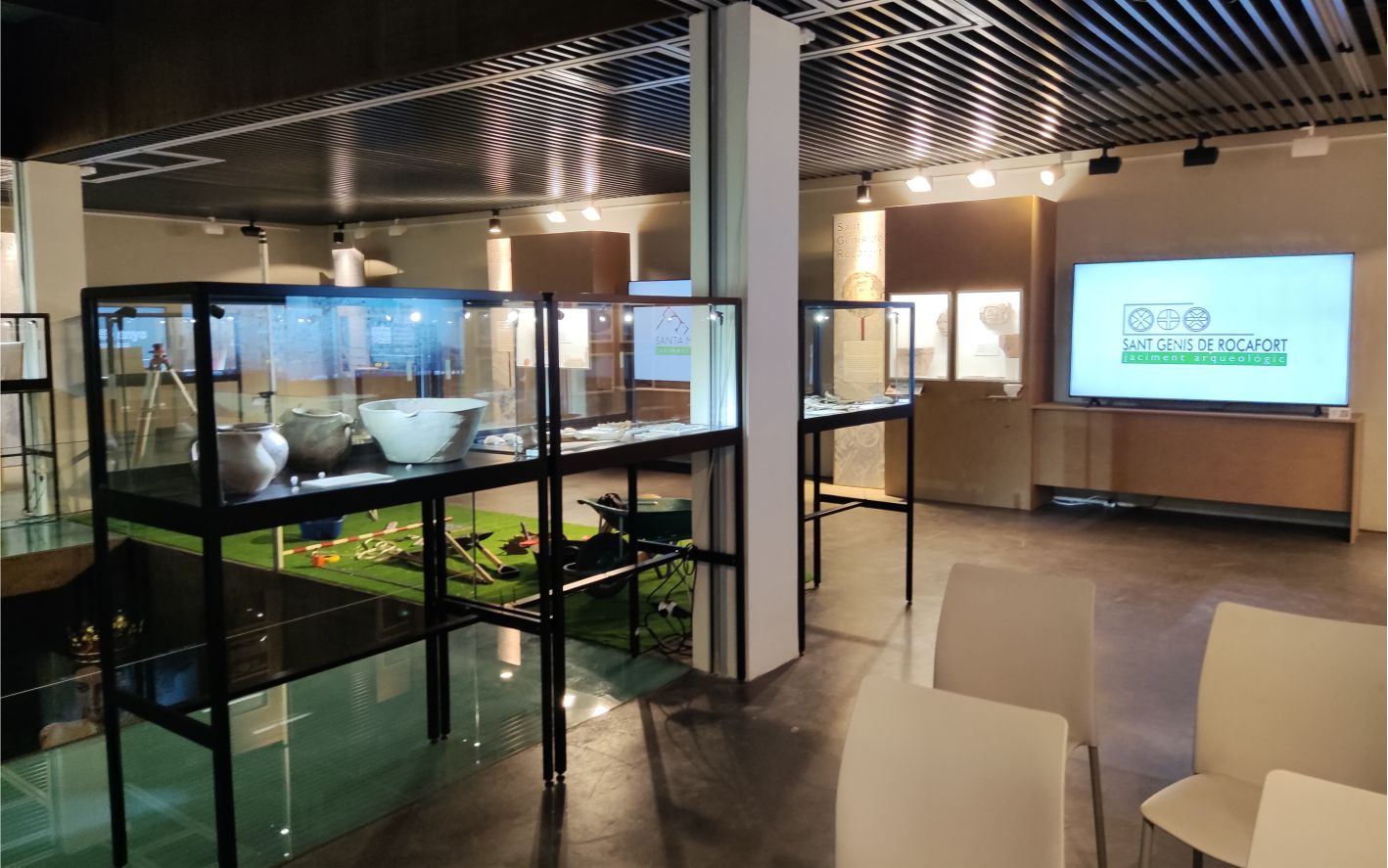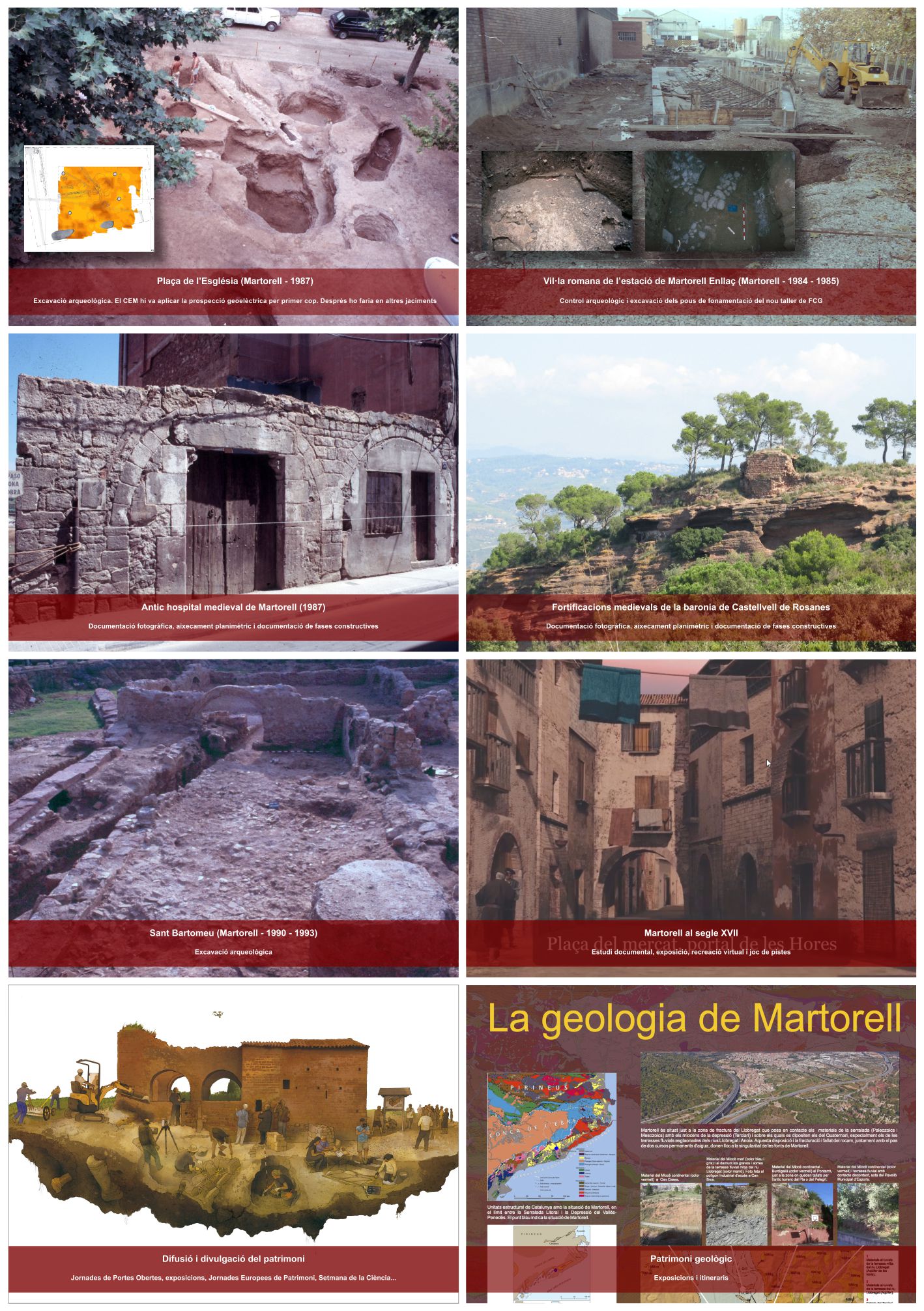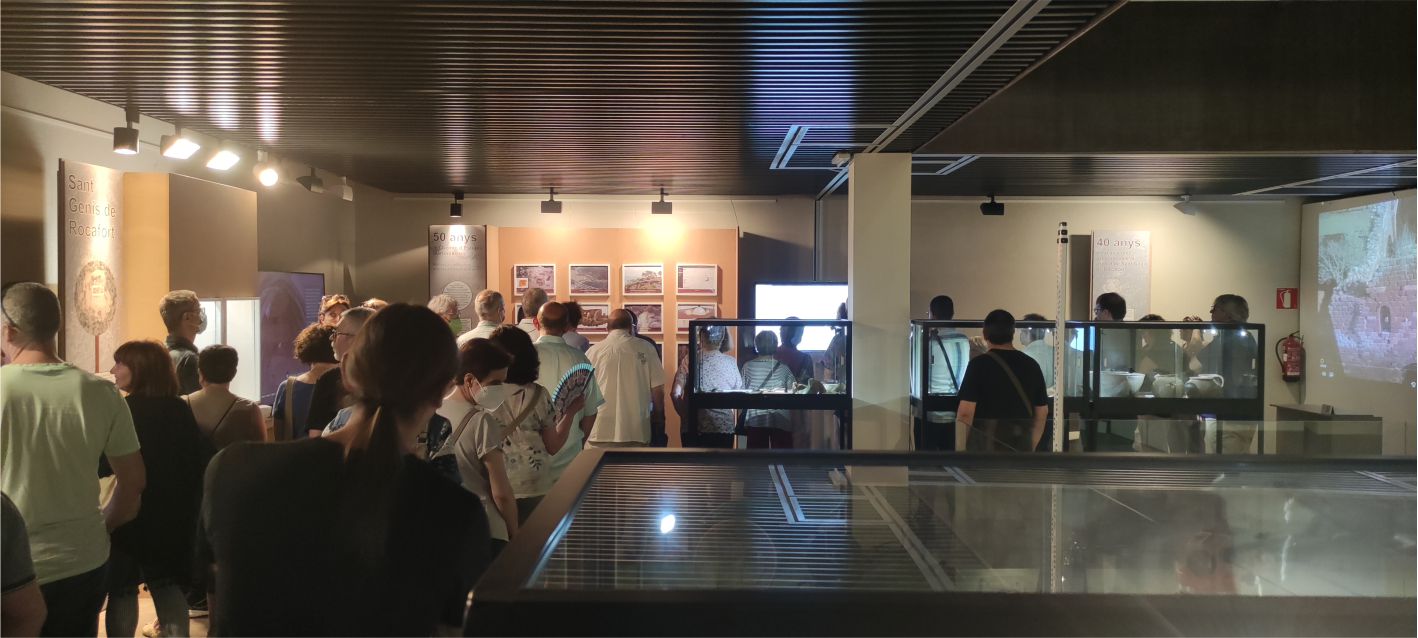Recently, Martorell has concluded many events dedicated to commemorating the fiftieth anniversary of an organization well rooted in the municipality, the Centre d’Estudis Martorellencs (CEM), which was founded in 1972. The aim of this article is to disseminate the museographic experience of the design and the implementation process of a temporary exhibition held on the occasion of this ephemeris, and also of another one that was developed in parallel —the fortieth anniversary of the formal archaeological excavations in the priory of Rocafort (Martorell), promoted by the very same center. Under the title CEM 50/40 Arqueologia. 50 anys de la fundació del Centre d’Estudis Martorellencs. 40 anys d’excavacions programades al priorat de Sant Genís de Rocafort, this exhibition aims at offering to the general public a retrospective look at the history of this association and an example of the work carried out throughout its first fifty years of existence. It is particularly focused on the research carried out in the field of archeology and the dissemination of the results obtained in two sites of reference for the municipality: Santa Margarida and the Monastery of Sant Genís de Rocafort.
The CEM 50/40 Arqueologia exhibition was born out of the will of the Centre d’Estudis Martorellencs, which is responsible for its original idea and design,(1) for the celebration of these significant anniversaries and for taking advantage of this ephemeris to look back, remember its own trajectory and disseminate it among the public. In this work, we aim at reporting on the previous reflection that gave rise to this exhibition, the contents created, the trajectory explained, and the different communication strategies put into practice to achieve our main goal. This goal is to involve society in our research, in the CEM's commitment to the conservation and dissemination of heritage, and in our wish to make the heritage management and its socialization a truly shared and co-responsible task for all the social agents entangled. The result of all this materialized in an exhibition that was open to visitors for six months, between 2 July and 18 December 2022, and which can currently be visited as an online virtual resource.
Accordingly, we structure our contribution in three parts: the first part is dedicated to briefly explaining (1) the history of the CEM and the research that is carried out there, which constitutes the raw material from which the contents of the exhibition were created. In the second one, we introduce (2) the structure of the exhibition and how its story was articulated, focusing on the different axes that have served as a common thread. The third one is aimed at assessing (3) the final implementation of the exhibition, the carried out activities, the communication strategies and the contribution that this experience can make in the field of museology.
El Centre d’Estudis MartorellencsThe Centre d’Estudis Martorellencs is a non-profit organization whose main asset is the people who selflessly collaborate with its cause. It operates fundamentally on the voluntary work carried out by its members to promote the knowledge and conservation of historical, cultural, and natural heritage. We encourage research on this heritage, while promoting the specific training of people dedicated to these research tasks in order to facilitate their job acquisition (Centre d’Estudis Martorellencs, 2012).
The CEM’s trajectory began in 1972 around a group of people interested in historical research who began their work in the context of the last years of the Franco regime, a time when a series of circumstances and initiatives came together, showing a society that was beginning to act more autonomously, escaping little by little the rigid control of the regime. The years immediately preceding had been of a certain cultural effervescence based on the contributions in some local publications such as the “Solc” magazine, where Antoni Pladevall had disseminated the Benedictine origins of the Sant Genís de Rocafort Monastery, contrary to the popular belief that attributed the monastery to a Templar foundation (Baucells, 2007, p. 3-4). This new reality spurred the CEM’s founding group to make a first approach to the farmhouse and the church of Santa Margarida. They started their recovery work and created the embryo of an entity that acquired legal personality in 1986, once its statutes were established and recognized.
After the cleaning and conditioning work and the first archaeological explorations, in September 1981 the systematic process of archaeological study began in Santa Margarida in collaboration with the University of Barcelona. Since then and during the following forty years, the formal excavations in Santa Margarida, together with the study of documentary sources, have uncovered an archaeological complex with a long chronology that starts in the fourth century and brings us practically to the present day. The most visible element of the complex is a partially ruined Romanesque church, under which we find the early Christian Basilica, surrounded by an extensive necropolis and a group of other buildings.
Since 2014, the call for grants for four-year projects in the field of archeology and paleontology promoted by the Government of Catalonia brought a certain transformation of the strategies for research and dissemination of Martorell's heritage. After the execution of a first four-year project (2014-2017) focused exclusively on the site of Santa Margarida, in 2018 the project was finally extended to the monastery of Sant Genís and the entire territory of the old priory. This is an archaeological site itself allowing us to relate the study of these two monuments to the evolution of the landscape, and thus offering us a comprehensive historical vision (Travé et al., 2021a).
The result of these forty years of systematic research has brought to light an unprecedented history of the municipality. However, throughout its first fifty years of existence, research at the Center of Studies of Martorell has not been limited to the study of the old priory of Rocafort. The CEM also carried out other research based on archaeological and documentary sources in different places around Martorell, while also promoting dissemination activities for the non-specialist public and making the results known in numerous forums and scientific publications (Mauri et al., 2020; Navarro and Mauri 1993; Travé et al., 2019; 2021b). In recent years, the protection and dissemination of natural heritage has also been incorporated with a certain intensity through guided tours and geological itineraries to disseminate the complexity of the natural environment of Martorell and the different anthropogenic transformations that had an impact on it over the centuries, thus also informing about the geological and natural history of the municipality.
All this activity—especially in the context of the archaeological research project, although not exclusively—has been accompanied by the methodological development that has made the CEM a space for methodological and instrumental innovation in archaeological research, while at the same time becoming a training scenario for archaeologists who have developed their professional activity in the sector. The creation of particularly outstanding technical resources in the application of digital technologies contributed to the CEM becoming a reference entity and put Martorell on the map of scientific research and dissemination (Travé et al., 2020). Therefore, it seems that its anniversary deserved a celebration that lived up to its standards and that made it possible to publicize the fruit of its research. It is in this spirit that the CEM 50/40 Arqueologia exhibition was conceived, so that it would constitute a meeting place with citizens to share experiences and memories, with an eye fixed on the years to come and the future of the association.
The temporary exhibition: structure and narrativeThe contents of the exhibition arise to commemorate the two milestones mentioned above, which coexist in space and time—the fifty years since the foundation of the Centre d’Estudis Martorellencs, marked by the beginning of the recovery of the archeological site of Santa Margarida, and the forty years of formal archaeological excavations. It is a long period during which stories and personal illusions converge with volunteering activities, the transformation of society, and the development of institutional heritage policies. The result of all this is what constitutes the main content of the exhibition, together with the results achieved so far through research.
The exhibition, located in the old Martorell cavalry barracks, currently rehabilitated as a heritage facility, has a deliberately circular structure, despite the building's square floor plan. The presence of a lightwell in the central area favors the circulation around it and allowed us to define the cyclical structure of the contents distributed along a circuit that rotates clockwise. The visit begins in a space especially aimed at children (Figure 2), in which different tactile activities and games give children the possibility to familiarize themselves with archeology as a science, through proposals that allow them to relate through illustrations and graphic resources the different tools of the field work with the function for which they are used.
It is also a space for the discovery of archaeological finds from various puzzles that reveal the shape of some of the finds made in Santa Margarida and Sant Genís throughout these forty years of research.
This children's space is integrated into the very narrative of the exhibition for the adult public, so that the journey through the history of the CEM begins with the children’s excitement, who make the exhibition a living space that allows the dialogue between generations. This youthful enthusiasm is what prompted the initial entry to Santa Margarida at the very beginning, and it is also what motivated for decades the interest in knowledge and discovery that moved the different members of the CEM at each stage to develop their scientific research on a heritage that was familiar to them. A narrative structure—a temporal succession of events linked to the idea of intertwined paths and individuals forming a human tapestry that shaped the personal and professional experiences of many of the members of the CEM—was the original idea conceived from the association from the very beginning, and we shaped it through the different contents generated.
This entry is what gives way to the successive exhibition modules, which include (1) the initial history of the CEM and its foundation, (2) the history of forty years of archaeological research, (3) the results of the research in Santa Margarida, (4) the most recent results obtained in Sant Genís, (5) a space for synthesis and a broad look at the other research activities carried out by the CEM and, finally, (6) a space for screening the film “Memories of Santa Margarida.” We will state some comments about the latter later.
Each of these spaces includes, with a different distribution, the projection of audiovisual resources, which form the guiding thread of the narrative, together with the display in showcases and panels of many significant objects from the history of the CEM and the research carried out. The links through QR codes to the audiovisual materials, which are also available on the YouTube channel of the Centre d’Estudis, enable both a quick visit to the exhibition and subsequent viewing of all the material, as well as a more leisurely experience in which the visitor can stop at each one of the resources.
Thus, the first module, dedicated to the founding moment of the CEM and its subsequent history, includes a screen where a video is projected following a timeline of the main milestones in the foundation of the center of studies, accompanied by abundant graphic and photographic material, as well as the precedents of the institution. In fact, archaeological research in the priory of Rocafort began as early as the 19th century from the specific excavations carried out at the site of Santa Margarida, probably following an initiative of Francesc Santacana, founder of the museum of L’Enrajolada in Martorell. Some of the materials recovered in those early excavations we kept there and are now exhibited in one of the showcases of this module. In a second showcase, the original documents of some remarkable milestones in the foundation of the CEM are displayed, such as the minutes or diaries of the first meetings in Santa Margarida to recover the site or the field notebooks of the first formal excavations that took place in 1981.
The second module is shorter and introduces, through a second video projected on a screen identical to that of the previous module, the journey of forty years of archaeological research. It goes from the initial works, still on the sidelines of the enactment of the heritage laws in autonomous regions, until the development of the formal interventions first in Santa Margarida and later on, in recent years, in Sant Genís too. This video is complemented by a large exhibiting space where the different tools used in field and laboratory work are displayed on a base of artificial grass. This area is the one giving way to the route to the two central modules (3 and 4) of the exhibition, where the results obtained at the Santa Margarida and Sant Genís sites are shown synthetically in two parallel structures.
In the video of Santa Margarida as well as in the video of Sant Genís, the visitor can be easily acquainted to the main discoveries made in both sites. Each of these screens is accompanied by a display case where some of the archaeological elements recovered in Santa Margarida and Sant Genís are displayed respectively. Three more display cases with some of the most significant finds recovered during the excavations include ceramic, metal, and bone material, which complement the explanation and can also satisfy the curiosity of more specialized audiences.
The next module (5) is dedicated to the other research and dissemination activities carried out by the CEM, which do not have the magnitude that we grant to the archaeological project of Santa Margarida and Sant Genís. In this space, by way of flashbacks, like a repertoire of memories or an album of photographs,
we display the main works carried out since the 1980s. Among these, there are archaeological excavations in the recovered Roman villa under the current Martorell-Enllaç train station, in Plaça de l'Església, in the Chapel of Sant Bartomeu or in the old Convent of Capuchins. The tasks of photographic, planimetric and architectural analysis documentation performed in the old medieval hospital, or in the medieval fortifications of the barony of Castellvell de Rosanes are also exposed, as well as the documentary and archaeological studies of the urban evolution of the medieval center of Martorell or the Devil’s Bridge. The exhibitions and itineraries across the geological heritage of the municipality, and, more recently, the virtual recreation work and participation in methodological innovation, information management and digitization projects are included as well.
Therefore, this retrospective glance takes us to the present, and the touch screen that accompanies this module contributes to expressing the continuity of this journey in the form of photographic memories. On this screen, visitors can discover the virtual tours prepared for the sites of Sant Genís and Santa Margarida, which are accessible online and constituted a fundamental tool for the CEM to keep in touch with its associates and followers during the lockdown period resulting from the covid-19 pandemic. The tour, therefore, offers a look at the present time as well, which includes some of the proposals that we currently offer as a cultural outreach activity.
Although the activity of the CEM has extended beyond the research in Santa Margarida—as shown at the end of the itinerary—it is true that it was this space that acted as a melting pot when it came to forming the entity. A considerable part of the personal and collective memories of the different members who have been part of the association throughout these fifty years was articulated around it. The visit, therefore, ends with a last video space where a documentary is continuously projected collecting over the course of thirty minutes the past experiences of some of the protagonists at the time of starting the formal research in Santa Margarida in 1981.
The documentary presents different witnesses who explain their impressions when discovering the site for the first time, who share their own experience of many years at the head of the research project, either as collaborators or as heritage professionals trained in Santa Margarida.
The documentary “Memories of Santa Margarida” is certainly that—a collection of memories that, nevertheless, traces the path to the future. The number of people who collaborated with the CEM, and especially those who have participated in the excavation campaigns, far exceeds three hundred. All of this adds up to a collective effort to which we wanted to pay tribute from the personal experiences of some of them, with a hopeful rather than nostalgic approach, and with testimonies that disseminate the generational baton that exists in the management of the different research projects carried out by the CEM.
Therefore, the circle closes, and then we could start the journey again filled with a childlike enthusiasm, while playing in the children's area and drawing the next fifty years of research, bringing new results and knowledge. In this way, we get to understand the structure and narrative of the exhibition as a metaphor for what has been the history of the institution and its forty years of archaeological research, because the restlessness and curiosity of its founders has been transmitted as legacy to new generations. The future projection of the CEM is possible because new generations driven by the same stimuli as their predecessors have integrated into the projects currently developed by the CEM in collaboration with other institutions in the academic field and in the public and private sectors, where their professional work often takes place. The CEM 50/40 Arqueologia exhibition was intended to be a tribute to all these people and an incentive for the public.
Reception, experience, and activitiesAround the exhibition, its opening and closure and during the months it remained open, the Center of Studies, jointly with Martorell Museums, offered a series of activities that saw a notable influx of attendees and became a meeting point for diverse audiences. The involvement of both the Martorell Town Council and the network of local museums made it possible to carry out activities around the exhibition, among which we underline the monthly guided tours open to the general public and also for reduced groups, whenever requested, as well as for school groups.
In this sense, the visit to the exhibition was yet another offer among the cultural activities offered by the municipality, and the integration of this resource into the different training proposals made by the CEM in collaboration with the Barcelona University was particularly remarkable. As part of the Fieldwork I and II subjects that are compulsory for Archeology students, the Santa Margarida site became a practice field for UB students. There, in addition to the regular hours of fieldwork, different members of the CEM offer specific training related to archaeological activity. This year, the visit to the exhibition was programmed as another formative activity, where the students were able to familiarize themselves with the history of the association while at the same time they were able to acquire knowledge about the site where they were working and learning museographic strategies through a guided tour especially aimed at this specialized audience.
It is in this context, with a young or middle-aged audience, that the exhibition's interactive resources work most efficiently. Certainly, with older audiences, access to audiovisual resources comes more effectively through other channels, such as the CEM mailing lists, where its different activities and proposals are advertised via e-mail. It is interesting to highlight, however, that this possibility of accessing the exhibition remotely, although it currently facilitates the distribution and permanence of the contents once withdrawn, has almost never replaced the personal experience of contemplating the different elements of the narrative in situ. A good example of this is the fact that audiences of all ages followed the entire viewing of the different videos, despite being well aware of the possibility of accessing them afterwards.
On the other hand, the exhibition was accompanied by a dossier of activities to do before, during and after the visit, aimed at children of school age and facilitated to schools as educational material through the educational proposals of Museums of Martorell. Since the beginning of the school year, a total of 292 school-aged children between the ages of 9 and 13 visited the exhibition, taking part in the guided tours. Our assessment of this participation is also positive. Initiatives of this kind are what have made it possible to link the association with the public and to establish meeting points and synergies that have become particularly successful. One of the activities to highlight was the opening event of the exhibition, which had around sixty attendees and became an enriching meeting point between two distinct segments of the public.
On the one hand, the segment of followers and sympathizers of the association—mostly from Martorell—who are part of the regular audience of the activities usually offered by the CEM in the form of small-format exhibitions, talks and open days during the archaeological excavation campaign. In this case, an audience interested in history and cultural heritage becomes its main consumer, although these visitors might not be direct agents of the activities promoted by the association. They are the main social segment to which the CEM addresses its proposals, especially through social networks and email distribution lists.
On the other hand, the inaugural event also succeeded in convening a series of past and present associates of the CEM who, throughout these fifty years, have taken an active part during more or less extended periods of time in the research tasks developed by the association. This is an audience that, due to the very vital trajectory of each one of them, maintained over the years a more emotional than pragmatic bond with the CEM, but in a moment of ephemeris and self-referential discourse did not hesitate to be present in a commemorative event that ended up being a meeting point and a place to remember. This allowed, in some cases, to revive the restlessness of research, recover past collaborations and generate new ones.
ConclusionsThroughout this article, we tried to share a museographic experience whose main characteristic was its commemorative nature and the will of a cultural association to celebrate fifty years of history, a present that is a reality in Martorell's cultural activity and a promising future in the field of basic research inside and outside the academic and professional circles. The approach of a temporary exhibition arising from the same entity that was its subject and that generated its contents was a privileged occasion to assess the center’s trajectory, to make it known to its fellow citizens and to contribute to the revaluation of local and regional heritage with a vision to the future.
The cyclical structure of the tour and its allegorical character of vital processes and cultural restlessness allowed us to tell the story of an entity that was born as a result of the fascination for the knowledge of its founding members. This fascination materialized throughout the years in the consolidation of research projects that, from a local area rooted in the territory, managed to put the municipality in the focus of current research. This vital journey of the institution, after fifty years, leads us to take a retrospective look that allowed us to recognize not only the successes of our work, but also its consolidation and continuity through new generations who grab the baton in the day-to-day tasks of the entity.
The preferred resource for audiovisual material accessible online allowed us not only to provide an experience for the visitor in situ, but also to enable a certain continuity of this experience afterwards, thanks to the option of recovering the materials that are part of the main body and are the guiding thread of the exhibition.
In short, CEM 50/40 Arqueologia was the result of collaborative work by the different members of the organization, carried out from the bottom up. It had the support and involvement of the local public administration, and it made it possible to reach a wide audience that strengthened the ties between a cultural entity and the citizens whom it wants to serve.
Notes
Credits: Museographic design: Project and direction: Center of Studies of Martorell. Audiovisual and video editing: Isidre Ot (Virtual Past) and Alfred Mauri. 3D infographic: Isidre Ot (Virtual Past). Pictures: Archive of the Center of Studies of Martorell, Núria Amat, Salvany Collection (National Library of Catalonia). Cinematic images: Lluís Garcia Vallès. Elements of movable heritage: Vicenç Ros Municipal Museum in Martorell. Production and assembly: Construction and facilities: Center of Studies of Martorell. Graphic printing: Artsdomotica, S.L.
Acknowledgments: Martorell Town Hall, Museums of Martorell, Martorell Library, Ferran Balanza.
Credits: Museographic design: Project and direction: Center of Studies of Martorell. Audiovisual and video editing: Isidre Ot (Virtual Past) and Alfred Mauri. 3D infographic: Isidre Ot (Virtual Past). Pictures: Archive of the Center of Studies of Martorell, Núria Amat, Salvany Collection (National Library of Catalonia). Cinematic images: Lluís Garcia Vallès. Elements of movable heritage: Vicenç Ros Municipal Museum in Martorell. Production and assembly: Construction and facilities: Center of Studies of Martorell. Graphic printing: Artsdomotica, S.L.
Acknowledgments: Martorell Town Hall, Museums of Martorell, Martorell Library, Ferran Balanza.
Bibliography
Baucells, J. (2007). El priorat de Sant Genís de Rocafort (Martorell). Center of Studies of Martorell.
CEM Center of Studies of Martorell (2012). Estatuts del Centre d’Estudis Martorellencs [statutes].
Mauri, A.; Del Fresno, P.; Baena, D.; Socorregut, J.; Navarro, R.; Farreny, M. and Travé, E. (2020). «L'arqueologia de l'arquitectura aplicada a les esglésies de Santa Margarida i Sant Genís del priorat de Rocafort (Martorell)». A X. Aquilué, J. Beltrán de Heredia, A. Caixal, J. Fierro, H. Kirchner (eds.), Estudis sobre ceràmica i arqueologia de l’arquitectura. Homenatge al Dr. Alberto López Mullor (p. 477-486). Barcelona Provincial Council.
Navarro, R. and Mauri, A. (1993). «Santa Margarida de Martorell: la transició de l’Antiguitat Tardana al món medieval». At IV Congreso de Arqueología Medieval Española (p. 341-344). Alicante Provincial Council.
Travé, E.; Del Fresno, P. and Mauri, A. (2020). «Ontology-mediated Historical Data Modelling: Theoretical and Practical Tools for an Integrated Construction of the Past». Digital Humanities Special Issue. Information, 11, 182; https://doi.org/10.3390/info11040182.
Travé, E., Navarro, R. and Mauri, A. (2021a). «Investigación arqueològica integral en el priorato de Rocafort: Yacimientos de Sant Genís y Santa Margarida (Martorell, Barcelona)». At M. Retuerce (ed.), Actas VI Congreso de Arqueología Medieval (España-Portugal), Alicante, 2019, (p. 615-620). Spanish Association of Medieval Archaeology.
Travé, E.; Navarro, R.; Mauri, A.; Farreny, M.; Del Fresno, P. and Socorregut, J. (2019). «De l’església paleocristiana a la sagrera medieval: Transformacions estructurals i ordenament intern del Jaciment de Santa Margarida (Martorell, Barcelona)». At J. López Vilar (ed.), Actas del 4º Congreso Internacional de Arqueología del Mundo Antiguo. VII Reunión de Arqueología Cristiana Hispánica (p. 181-188). University of Rovira i Virgili.
Travé, E.; Tella, J. M.; Del Fresno, P.; Socorregut, J. and Mauri, A. (2021b). «Assessing natural vs anthropogenic horizons through deposit modelling strategies at the Medieval Site of Santa Margarida (Martorell, Barcelona, Spain)», Geoarchaeology, 36(3), 511-531. https://doi.org/10.1002/gea.21844.

 MNEMÒSINE REGISTRY
MNEMÒSINE REGISTRY 

